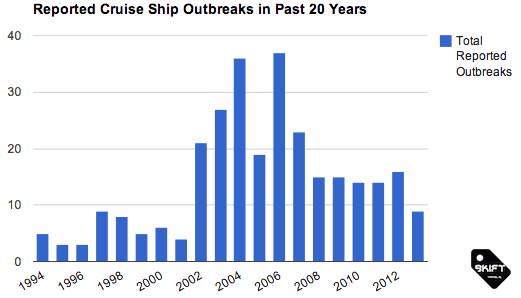Skift Take
The cause of a norovirus, whether it's a single passenger or malfunctioning dishwasher, is almost impossible to pinpoint making it tough for the CDC or cruise lines to say when, if ever, the risk will be mitigated.
It’s only one month into 2014 and there have already been three outbreaks of stomach flu on U.S. cruise ships.
Last month was one of the worst Januarys for cruise ship gastrointestinal illness outbreaks in the past six years. Three ships returned to U.S. ports last month with at least 5 percent of passengers with a stomach flu. The last time more than two cruise ships reported outbreaks in January was 2006.
Norovirus, better known as the stomach flu, was the cause of two of the three outbreaks. It was revealed yesterday that a new strain of the virus was responsible for almost 700 illnesses on Royal Caribbean’s Explorer of the the Seas.
Norovirus is the most common cause of gastrointestinal illness outbreaks on cruise ships. According to CDC data, norovirus caused 67 percent of the 292 reported cruise ship outbreaks in the past 20 years. In reality, the number is likely even higher since the cause of 22 percent of outbreaks is unknown or wasn’t tested.
| Causative Agent | Outbreaks (%) Over Past 20 Years |
|---|---|
| Norovirus | 67% |
| Unknown | 12% |
| Specimen Not Taken | 10% |
| Other Agent | 11% |
Norovirus is responsible for 86 percent of outbreaks with a known cause in the past 20 years.
Underreported Cases
Cruise ships are only required to alert the CDC of an outbreak if two percent or more of passengers and crew onboard fall ill. If fewer than two percent of passengers and crew onboard are identified as ill, the ship is not required to report the cases to the CDC.
Also, not all passengers and crew that fall ill report it to the ship’s medical center.
“There are more cases that we do not see because they do not meet the 2 percent threshold,” explains a CDC spokesperson.
“Every case that was filed to the CDC does not represent every person on a ship. The numbers are always going to be slightly higher than what is reported on the website.”
Twenty Years of Outbreaks
There have been 292 reported cases of virus outbreaks on cruise ships that dock in U.S. ports over the past 20 years. An average of 6.6 percent passengers have been ill in each case reported in the past ten years.
Although the CDC has records on outbreaks dating back to the 1970s, it only publicly shares records from the past 20 years online. A CDC spokesperson says the 2-percent threshold requirement and cleaning procedures have not been changed in past 13 years.
“Outbreaks were higher in the 1970s and ’80s. What we’ve seen in the last ten years is not unique in the broader scheme of things.”
Norovirus: Not Just a Menace to Cruise Ships
Norovirus is described by the CDC as a “very hearty virus” that causes stomach pain, nausea, and diarrhea. It can be contracted from contact with an infected person, contaminated food or water, or by touching contaminated surfaces.
Norovirus’ prevalence isn’t unique to cruise ships.
The virus is considered the most common cause of acute gastroenteritis in the U.S. and causes between 19 million and 21 million illnesses on sea and land a year. It also annually contributes to 56,000 to 71,000 hospitalizations and 570 to 800 deaths.
It’s presence on cruise ships is alarming as the number of people sharing a confined space fuels the spread of the disease.
“Any time you have large groups of people gathering in small confined groups, the likelihood of GI outbreaks increases,” says a CDC spokesperson.
“We’ve responded to GI-like illness at Boy Scout camps, college dorms, nursing homes, and casinos. What you see on cruise ships is small in comparison to norovirus outbreaks on land.”
The Daily Newsletter
Our daily coverage of the global travel industry. Written by editors and analysts from across Skift’s brands.
Have a confidential tip for Skift? Get in touch
Tags: cdc, health, royal caribbean
Photo credit: Paramedics dressed in protective attire walk in front of the ship, the Bellriva, in Wiesbaden December 8, 2012. Lisi Niesner / Reuters

